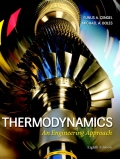
a)
The total entropy change and exergy destruction by treating the mixture as an ideal gas.
a)
Answer to Problem 71P
The entropy generated is
The energy destroyed is
Explanation of Solution
Write the entropy balance equation to obtain the expression of entropy generation in terms of
Here, mass of
Write the expression to obtain the energy destroyed during a process
Here, initial temperature is
Conclusion:
Refer Table A-2b, “Ideal gas specific heats of various common gases”, obtain the specific heat at constant pressure of
Obtain the value of
Here, constant pressure specific heat is
The partial pressure of
Substitute
Obtain the value of
The partial pressure of
Substitute
Substitute 6 kg for
Thus, the entropy generated is
Substitute 293 K for
Thus, the energy destroyed is
b)
The total entropy change and exergy destruction by treating the mixture as a non ideal gas using Amagat’s law.
b)
Answer to Problem 71P
The entropy generation is
The energy destroyed is
Explanation of Solution
Write the expression to obtain the initial reduced temperature of
Here, critical temperature of
Write the expression to obtain the initial and final reduced pressure of
Here, critical temperature of
Write the expression to obtain the final reduced temperature of
Here, critical temperature of
Write the expression to obtain the initial reduced temperature of
Here, critical temperature of
Write the expression to obtain the initial and final reduced pressure of
Here, critical temperature of
Write the expression to obtain the final reduced temperature of
Here, critical temperature of
Write the expression to obtain the entropy change for
Write the expression to obtain the entropy change for
Here, number of moles of
Write the expression to obtain the surrounding entropy change
Here, surrounding heat is
Write the expression to obtain the entropy generation
Write the expression to obtain the energy destroyed during a process
Here, initial temperature is
Conclusion:
Substitute 160 K for
Substitute 5 MPa for
Substitute 200 K for
Refer Figure A-30, “Generalized entropy departure chart”, obtain the value of
Substitute 160 K for
Substitute 5 MPa for
Substitute 200 K for
Refer Figure A-30, “Generalized entropy departure chart”, obtain the value of
Substitute
Substitute 0.75 kmol for
Substitute –4,745 kJ for
Substitute
Thus, the entropy generation is
Substitute 293 K for
Thus, the energy destroyed is
Want to see more full solutions like this?
Chapter 13 Solutions
EBK THERMODYNAMICS: AN ENGINEERING APPR
- Find temperatures STRICTLY USING RITZ APPROXIMATION METHODarrow_forwardSolve this Problem using RITZ APPROXIMATION. STEP BY STEParrow_forwardB/40 The body is constructed of a uniform square plate, a uniform straight rod, a uniform quarter‐circular rod, and a particle (negligible dimensions). If each part has the indicated mass, determine the mass moments of inertia of the body about the x‐, y‐, and z‐axes. Answer Given.arrow_forward
- (read image) Answer:arrow_forward(read image) Answer Givenarrow_forwardB/16. The plane area shown in the top portion of the figure is rotated 180° about the x‐axis to form the body of revolution of mass m shown in the lower portion of the figure. Determine the mass moment of inertia of the body about the x‐axis. Answer Givenarrow_forward
- (read image) Answer:arrow_forward(read image) Answer:arrow_forward2nd Law of Thermodynamics A 1.5-ft3 rigid tank contains saturated refrigerant-134 at 170 psia. Initially, 20 percent of the volume isoccupied by liquid and the rest by vapor. A valve at the top of the tank is now opened, and vapor is allowedto escape slowly from the tank. Heat is transferred to the refrigerant such that the pressure inside the tankremains constant. The valve is closed when the last drop of liquid in the tank is vaporized. Determine thetotal heat transfer for this process.arrow_forward
- Draw the shear and bending-moment diagrams for the beam and loading shown, and determine the maximum normal stress due to bending. 4.8 kips/ft 32 kips B C D E I Hinge 8 ft. 2 ft 5 ft 5 ft W12 x 40arrow_forward2nd Law of Thermodynamics A rigid, insulated tank that is initially evacuated is connected through a valve to the supply line that carrieshelium at 300 kPa and 140◦C. Now the valve is opened, and helium is allowed to flow into the tank until thepressure reaches 300 kPa, at which point the valve is closed. Determine the flow work of the helium in thesupply line and the final temperature of the helium in the tank.arrow_forwardDraw the shear and bending-moment diagrams for the beam and loading shown, and determine the maximum normal stress due to bending. 5 kips 10 kips B I W14 x 22 -5 ft -8 ft 5 ft-arrow_forward
 Elements Of ElectromagneticsMechanical EngineeringISBN:9780190698614Author:Sadiku, Matthew N. O.Publisher:Oxford University Press
Elements Of ElectromagneticsMechanical EngineeringISBN:9780190698614Author:Sadiku, Matthew N. O.Publisher:Oxford University Press Mechanics of Materials (10th Edition)Mechanical EngineeringISBN:9780134319650Author:Russell C. HibbelerPublisher:PEARSON
Mechanics of Materials (10th Edition)Mechanical EngineeringISBN:9780134319650Author:Russell C. HibbelerPublisher:PEARSON Thermodynamics: An Engineering ApproachMechanical EngineeringISBN:9781259822674Author:Yunus A. Cengel Dr., Michael A. BolesPublisher:McGraw-Hill Education
Thermodynamics: An Engineering ApproachMechanical EngineeringISBN:9781259822674Author:Yunus A. Cengel Dr., Michael A. BolesPublisher:McGraw-Hill Education Control Systems EngineeringMechanical EngineeringISBN:9781118170519Author:Norman S. NisePublisher:WILEY
Control Systems EngineeringMechanical EngineeringISBN:9781118170519Author:Norman S. NisePublisher:WILEY Mechanics of Materials (MindTap Course List)Mechanical EngineeringISBN:9781337093347Author:Barry J. Goodno, James M. GerePublisher:Cengage Learning
Mechanics of Materials (MindTap Course List)Mechanical EngineeringISBN:9781337093347Author:Barry J. Goodno, James M. GerePublisher:Cengage Learning Engineering Mechanics: StaticsMechanical EngineeringISBN:9781118807330Author:James L. Meriam, L. G. Kraige, J. N. BoltonPublisher:WILEY
Engineering Mechanics: StaticsMechanical EngineeringISBN:9781118807330Author:James L. Meriam, L. G. Kraige, J. N. BoltonPublisher:WILEY





